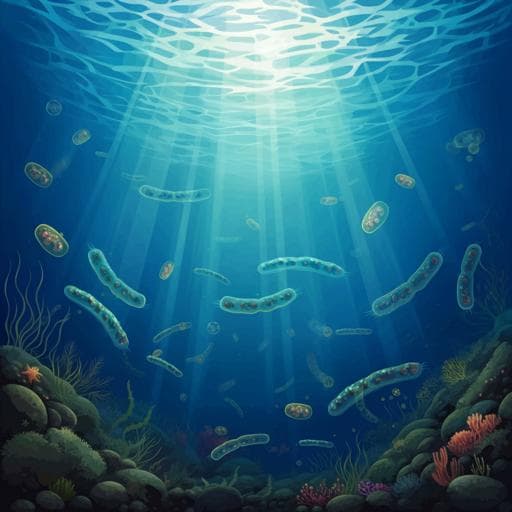
Earth Sciences
Adaptive carbon export response to warming in the Sargasso Sea
M. W. Lomas, N. R. Bates, et al.
This groundbreaking study reveals that despite rising temperatures and reduced nutrients in the Sargasso Sea, the export of particulate carbon remains robust. Researchers Michael W. Lomas, Nicholas R. Bates, Rodney J. Johnson, Deborah K. Steinberg, and Tatsuro Tanioka highlight remarkable shifts in phytoplankton communities that enhance nutrient efficiency, suggesting a resilience in ocean ecosystems that defies current models.
~3 min • Beginner • English
Introduction
Phytoplankton regulate ocean biogeochemical cycles and marine food webs, and there is broad concern that upper-ocean warming and stratification reduce vertical nutrient inputs, driving declines in phytoplankton biomass, net primary production (NPP), and carbon export. The magnitude of these changes depends on elemental stoichiometry (C:N:P), with models differing in predictions when stoichiometry is fixed versus flexible. Flexible stoichiometric models suggest smaller declines in NPP and export due to enhanced nutrient use efficiency, though potentially offset by shifts toward smaller phytoplankton. The Sargasso Sea features highly flexible stoichiometry and significant contributions of cyanobacteria (Synechococcus and Prochlorococcus) to particulate carbon export. Using three decades of observations at the Bermuda Atlantic Time-series Study (BATS), the study asks: (1) Does surface warming covary inversely with nutrient inventories? (2) Do plankton communities show stable or variable taxonomic and elemental composition? (3) How do these interactions impact carbon export?
Literature Review
Prior work documents global warming-driven stratification linked to decreased chlorophyll and phytoplankton biomass, with bottom-up controls (temperature, nutrients, light) affecting NPP. Fixed stoichiometry models project up to ~20% declines in global NPP, while flexible stoichiometry models predict <10% reductions and smaller decreases in export via increased nutrient use efficiency. Subtropical gyres and the Arctic are particularly sensitive. In the Sargasso Sea, cyanobacteria contribute to efficient carbon export despite oligotrophic conditions, and the region is often phosphorus limited with very low phosphate. Studies have highlighted aggregation of picophytoplankton into sinking particles, zooplankton mediation (including salps) of export, and preferential remineralization of phosphorus, all of which could decouple carbon and nutrient cycles and sustain export under nutrient stress.
Methodology
Study location and sampling: Monthly (biweekly in spring) BATS cruises near 31°40'N, 64°10'W employed quasi-Lagrangian sampling within a 0.25° × 0.25° box. CTD/hydrocasts provided continuous profiles; mixed layer depth was estimated using a 0.2 °C variable sigma-criterion. Surface (10 m) temperature anomalies were seasonally detrended.
Nutrients: Dissolved inorganic nitrate and phosphate were filtered (0.8-µm), frozen, and analyzed via standard autoanalyzer methods. High-sensitivity soluble reactive phosphate (MAGIC-SRP) was measured from October 2004 using the modified MAGIC method with certified standards and a 3000 m internal standard. Dissolved organic phosphorus (DOP) inventories were compiled (Supplementary).
Particulates: Particulate organic carbon (POC), nitrogen (PON), and phosphorus (PP) were collected on precombusted GF/F filters, stored frozen, and analyzed on a Control Equipment 440-XA elemental analyzer; PP via ash-hydrolysis with efficiency checks.
Picoplankton abundance and biomass: From June 2002 onwards, samples were preserved (0.5% paraformaldehyde), flash-frozen, and analyzed by flow cytometry to enumerate Synechococcus, Prochlorococcus, picoeukaryotes (<3 µm), and nanoeukaryotes (>3 µm). Carbon biomass was derived from abundance using a normalized cell size–carbon relationship. An independent estimate of total phytoplankton carbon was derived from the slope of the integrated POC vs. Chl-a regression multiplied by integrated Chl-a, enabling exclusion of non-phytoplankton POC via the intercept.
Particulate fluxes: Sinking POC, PON, and PP fluxes were measured at 150, 200, and 300 m with surface-tethered particle interceptor traps. Fluxes were calculated from collected mass, trap area, and deployment time. From October 2008 a blank correction (2.3% of raw POC, 4.5% of PON) was applied uniformly to the record.
Primary production: In situ 14C-uptake incubations used surface-tethered arrays with samples every 20 m from the surface to 140 m. Rates were corrected for dark uptake and integrated to 140 m. Sampling platforms transitioned from Go-Flo (1990–2005) to CTD-Niskin (from 2004).
Trait-based model: A modified mechanistic trait-based stoichiometry model (after Inomura et al.; Tanioka et al.) predicted phytoplankton C:P as a function of satellite-derived growth rate (CPM), Chl:Cphyto (from MODIS-Aqua), and P limitation inferred from SST relative to a phosphate depletion temperature. Parameterization used Synechococcus linearis with a hard-bound maximum C:P of 335 at zero growth (consistent with marine Synechococcus WH8102). Monthly area-averaged C:P over a 3×3 pixel around BATS was computed for the surface 100 m.
Key Findings
- Surface warming and mixing: Near-surface temperature at 10 m increased by ~0.9 °C from 1990–2020, with accelerated warming in the 2010s (0.119 ± 0.008 °C yr⁻¹, R²=0.10, P<0.001) versus a weak rise in the 1990s (0.035 ± 0.013 °C yr⁻¹, R²=0.01, P=0.007) and no significant trend in the 2000s. The seasonal mixing amplitude (winter–summer mixed layer depth difference) declined significantly in the 2010s (R²=0.46, P=0.03), driven by shallower winter mixing.
- Nutrient inventories and NPP: 0–140 m nitrate and phosphate inventories declined significantly in the 2010s (nitrate slope −11.6 ± 1.6 mmol m⁻² yr⁻¹, R²=0.34, P<0.001; phosphate slope −0.43 ± 0.06 mmol m⁻² yr⁻¹, R²=0.36, P<0.001), amounting to 25–30% reductions relative to pre-2010. DOP inventories also decreased. Integrated NPP declined ~30% (slope −22.2 ± 6.8 mg C m⁻² yr⁻¹; P=0.002, R²=0.09).
- Carbon export: Contrary to model expectations, particulate organic carbon flux at 150 m did not significantly decrease in the 2010s (P=0.785). The export ratio (export:NPP) rose from 0.04 (2010) to 0.16 (2019), indicating greater export efficiency.
- Plankton community and biomass: Eukaryotic phytoplankton lost their pronounced seasonal biomass peak and remained at baseline levels similar to pre-2010 minima; Prochlorococcus and Synechococcus biomass did not show contemporaneous declines. Total phytoplankton biomass decreased significantly (FCM PhytoC slope −0.08 ± 0.2 g C m⁻² yr⁻¹; Total PhytoC slope −0.05 ± 0.01 g C m⁻² yr⁻¹), while phytoplankton growth rates showed no significant long-term trend (P>0.2) and similar means pre/post-2010 (P>0.4), implying NPP declines were biomass-driven.
- Export stoichiometry: Phosphorus export flux declined while C and N export did not, driving increases in exported C:P and N:P at 150 m: C:P slope 86 ± 13 units yr⁻¹; N:P slope 11.4 ± 1.8 units yr⁻¹; pre-2010 vs. end-2010s C:P 205 ± 108 to 722 ± 226; N:P 29 ± 14 to 101 ± 35 (both P<0.001). Export C:N averaged 7.23 ± 1.61 and did not change significantly. Similar patterns occurred at 200 and 300 m with reduced magnitudes due to remineralization.
- Seston stoichiometry: In the upper euphotic zone (0–60 m), POC:PP (C:P) increased (R²=0.17, P<0.001; slope 14.5 ± 2.9 units yr⁻¹) and PON:PP (N:P) increased (R²=0.08, P=0.02; slope 1.48 ± 0.5 units yr⁻¹). Ratios in 60–100 m were lower by ~17% (C:P) and ~30% (N:P). Euphotic zone ratios were consistently lower than export ratios, indicating enhanced shallow remineralization of P (and N) between 100–150 m.
- Modeled phytoplankton C:P: Trait-based estimates (2003–2020) matched bulk seston magnitude and increased in the 2010s (slope 4.3 ± 1.4 units yr⁻¹; P=0.002), consistent with cyanobacterial dominance and physiological adjustments.
- Partitioning of export stoichiometry change: Approximately 20% of the increase in exported C:P is attributed to changes in the stoichiometry of source particulate matter; ~80% is attributed to enhanced shallow demineralization (“nutrient trapping”).
Discussion
The 2010s exhibited intensified warming and stratification at BATS, reducing winter mixing and nutrient resupply, which led to declines in nitrate, phosphate, and NPP. Despite this, carbon export at 150 m remained stable and the export ratio increased, indicating a decoupling of NPP from export. The mechanisms include: (1) flexible phytoplankton stoichiometry and community shifts favoring cyanobacteria with elevated cellular C:P, increasing nutrient use efficiency; and (2) enhanced shallow remineralization of phosphorus (and nitrogen) between the base of the euphotic zone and 150 m, effectively trapping limiting nutrients shallowly and sustaining export carbon fluxes while reducing P flux. Seston and export stoichiometry co-varied, with export C:P and N:P rising markedly, while C:N remained near Redfield-like values. Additional ecosystem processes may contribute, including physical aggregation of picophytoplankton into large sinking particles and zooplankton mediation of flux (notably salps that efficiently package picophytoplankton into fast-sinking fecal pellets and do not respire excess C to the same extent as micro- and mesozooplankton). Collectively, these responses demonstrate biological and food-web adaptations that buffer carbon export against nutrient-driven declines in primary production, a behavior underrepresented in many earth system models.
Conclusion
Long-term BATS observations reveal that accelerated surface warming and reduced nutrient inventories in the 2010s were accompanied by a pronounced decline in NPP but not by the expected decline in particulate carbon export. Instead, export efficiency increased, driven by a shift toward cyanobacteria and higher cellular C:P, together with enhanced shallow remineralization of phosphorus that maintained carbon flux while reducing P export. These adaptive ecosystem responses indicate that surface ocean biogeochemistry can rapidly reorganize under climate forcing and that flexible stoichiometry and trophic mediation should be more explicitly incorporated into global models of the biological carbon pump. Future work should quantify mesopelagic remineralization pathways, resolve long-term in situ phytoplankton elemental stoichiometry, and better constrain zooplankton community dynamics (including salps) to attribute export mechanisms under continued warming.
Limitations
Direct long-term time series of phytoplankton elemental stoichiometry are lacking; modeled C:P relied primarily on Synechococcus parameterization and satellite inputs. Bacterial productivity data between 100 and 150 m during the 2010s are sparse, limiting attribution of enhanced shallow remineralization to specific microbial processes. Post-2011 salp abundance and detailed zooplankton community changes were not fully analyzed, preventing a quantitative assessment of trophic mediation of export. Episodic events (e.g., 2010 NAO anomaly) complicate simple coupling between NPP and export. Sediment trap measurements, while corrected, retain inherent uncertainties.
Related Publications
Explore these studies to deepen your understanding of the subject.







